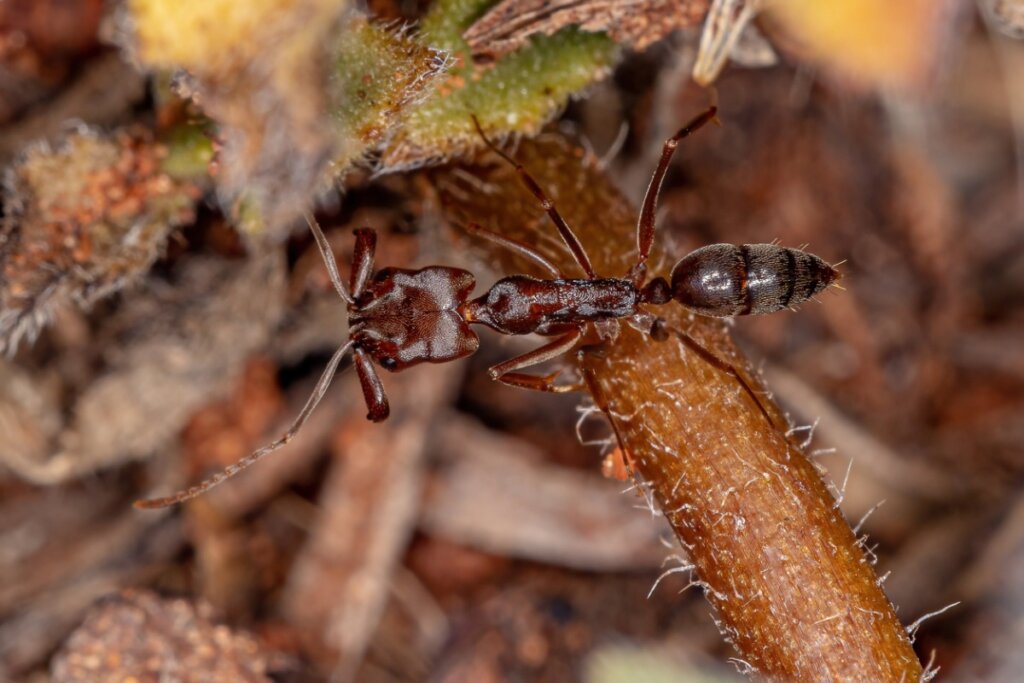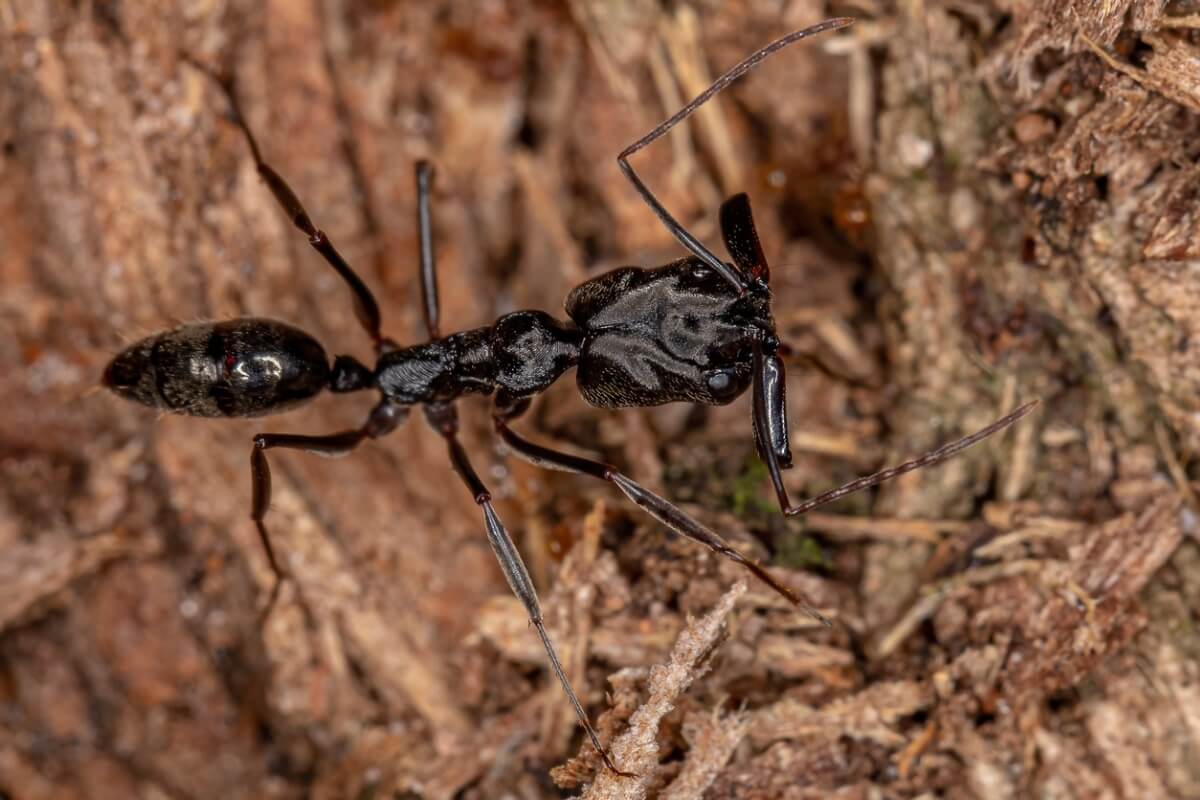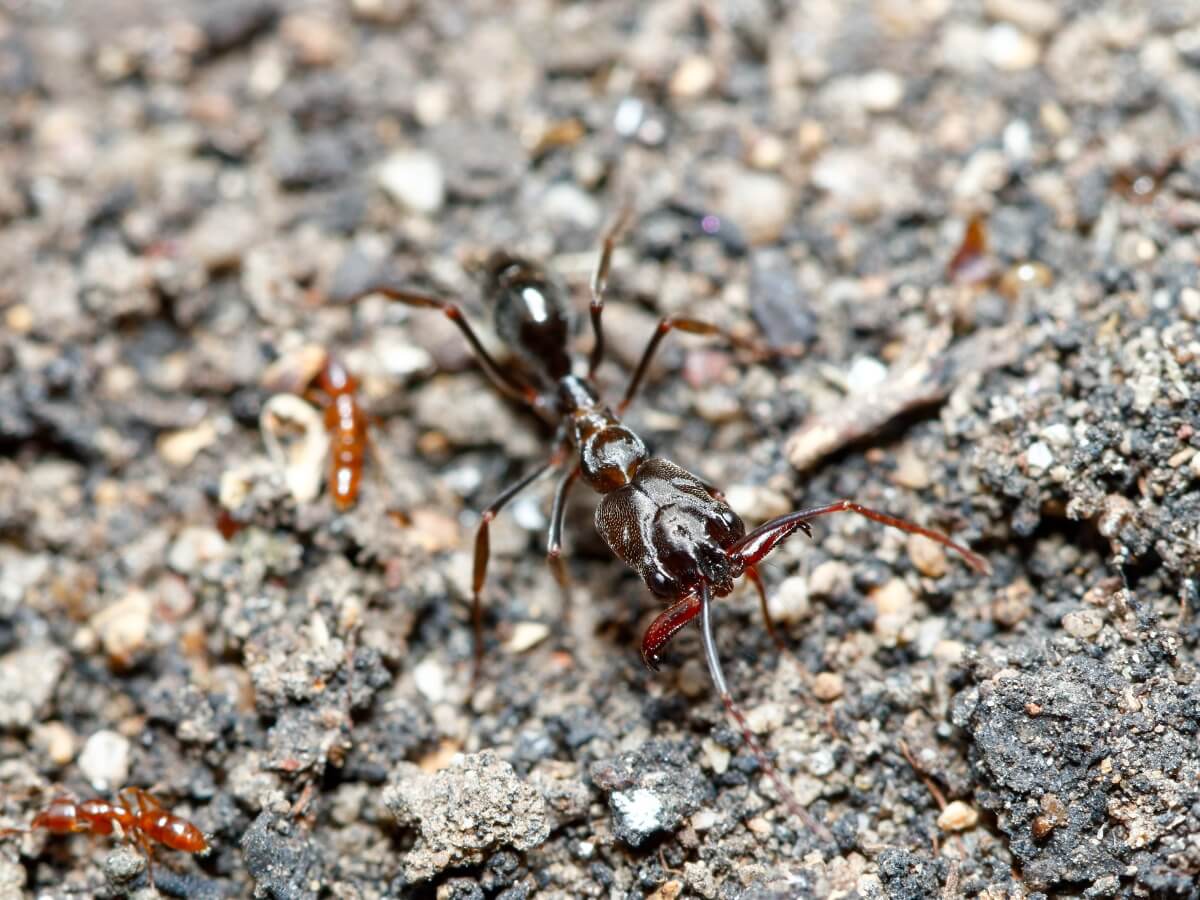Trap-Jaw Ants: Habitat and Characteristics

Ants are one of the best-adapted insects on this planet, as they can be found on almost every continent in the world. Although they’re usually quite small, some specimens have incredible mechanisms for hunting. An example of this are the trap-jaw ants, which have a mouth that operates like a powerful spring.
Ants that have these modified mouth structures belong to the genus Odontomachus. This group is part of the subfamily Ponerinae, which also includes the giant ants of the Amazon and many other species with powerful jaws and stingers. Read on and learn a little more about these amazing ants.
Where do trap-jaw ants live?
These ants live in the tropical regions of several countries, but are much more diverse in Asia. Therefore, they prefer to inhabit temperate forests where there’s plenty of moisture and a variety of prey. They also take advantage of moist soil, leaf litter, or tree branches to build their nests.
What do trap-jaw ants look like?
These ants are among the largest in existence, ranging in size from 4 to 20 millimeters in length. Like many other insects, their bodies are divided into 3 different sections: head, thorax and abdomen. The last two parts have the typical “wasp waist” as a joining point, which is a distinctive feature of the Hymenoptera.
The main feature of these insects is their gigantic claw-like, serrated mandibles. These insects use them as a kind of trap, as they’re able to close this structure in just 0.1 microseconds. Thanks to this, they have a fast lethal tool to hunt their prey.
Although it may not seem so, the mechanism of this structure is quite complex, as some sensitive “hairs” are responsible for activating the trap. The ants open their huge “pincers” 180 degrees and wait for their prey to touch the hairs. The closing movement is so fast that the victim can’t react, which ensures a perfect catch for the predator.

Castes within trap-jaw ants
Like most Formicidae, trap-jaw ants have several castes within their nests. Each exhibits different characteristics, as they specialize in performing certain tasks for the colony. In fact, it can be said that each individual in the nest has a defined role from birth:
- Workers: These are in charge of hunting, gathering food, and defending the nest, and this caste has trap jaws. In some species, the workers are able to lay eggs and serve as substitute queens when the main matriarch dies.
- Males (winged or non-winged): These are the copulators of the anthill and mate with the queens in order to fertilize them and produce their fertile eggs. This caste is born from non-fertile eggs and is only present in the reproductive season of the anthill.
- Queen (winged or non-winged): This is the main reproductive agent of the nest, and is in charge of producing all the other castes. In these species, the queen also helps to collect food and hunt, and so it also has the trap-jaw.
- Unfertilized queens or “virgin queen ants” (winged or non-winged): These queens are in charge of forming new colonies, but they need to be fertilized by the males and migrate to a new site. This caste is only present during the reproductive season of the anthill.
What do trap-jaw ants eat?
These formicids are considered generalists, as they’re capable of feeding on a wide variety of organisms. According to an article published in the scientific journal Annals of the Entomological Society of America, this flexibility allows them to adapt to the seasonal changes of the year.
In other words, the ants change their diet each season to ensure that there’s sufficient prey and no shortage of resources. As a result, they feed on a wide variety of small arthropods, fruits, seeds, and nectar.
How do they hunt?
To begin with, ants open their mandibles 180 degrees to activate their hunting mechanism. Once the position of their mouth structure is fixed, they begin to move forward while scanning the terrain with their antennae. During the hunt, this insect’s muscles are ready to close the pincers, but it doesn’t do so until the hairs of its mandible are stimulated.
Thus, the ant makes sure that the trap is activated only when an insect appears in front of it. Otherwise, the mechanism remains ready to act at any time. All of this doesn’t guarantee that they’ll catch their prey though, because in a few cases they manage to escape. If this happens, the ant doesn’t get hurt, because its jaw stops before it can cause damage.
Are there other types of ants with trap jaws?
Although it would seem to be a unique feature, these trap-like jaws are also present in other taxonomic groups. For this reason, the genus Odontomachus isn’t the only genus that can contain ants of this type. Some examples of this are the following genera:
- Anochetus: This group is the closest to Odontomachus and both belong to the same subfamily (Ponerinae). In fact, the only difference between each one is the shape of their heads, since the jaws maintain the same mechanism, but with slight distinctions in their shape that aren’t very noticeable.
- Myrmoteras: These ants have a trap-jaw mechanism that’s very similar to that of Anochetus and Odontomachus. However, their group isn’t related to any of them. Unlike the previous ones, their jaw has very evident teeth, while the mechanism is activated by means of a long sensitive “hair” located right in the middle.
- Strumygenis: This group obtained its trap jaws independently, as it isn’t related to the previous taxa. For this reason, its mouth structure resembles medical “forceps” instead of pincers. Also, the size of the mandible is usually smaller than that of the other ants.
Jaws are useful for more than just hunting
Although the primary function of trap jaws is to hunt, ants have developed strategies to use them in other ways. Some other uses for this incredible structure are the following:
- Digging: Thanks to the fact that it’s quite long, the mandible works perfectly as a shovel, so these insects can build tunnels in the anthill quickly.
- Defense: Even if their prey doesn’t fall into the trap, the force the powerful pincers close with causes a shock wave that can throw the intruders away. In this way, they use the mandible as a sort of air gun that drives away any invaders.
- Flight: When the ant is in imminent danger, it uses this powerful air gun in reverse, jumping away from the threat.
- Egg care: Although the mouth structure is usually capable of destroying and cutting up entire insects, it can also be used as a delicate pincer. Thanks to this, the workers are able to take care of the colony’s eggs without accidentally crushing them.
Predators that are also prey
It’s likely that, at first glance, these ants may seem invincible, as they have such a powerful lethal weapon in their power. However, in nature, things aren’t often as easy as that, as even these amazing creatures have predators that are well adapted to hunt them.
The hunter of choice for some of these species is known as Formica archboldi, another species of ant that camouflages itself to catch its prey. To do so, it uses the same “scent” as the trap-jaw ant, with which it’s able to infiltrate, gain its trust and devour it when it’s not looking.
As if that wasn’t enough, this predator doesn’t only end the life of its unsuspecting victim; it also uses its body parts to decorate its nest. Despite their ferocious appearance, trap-jaw ants can’t do much against their incredible predator.

Ants are one of the most morphologically varied insects, which makes them so fascinating. Trap-jaw ants are no exception, as their great speed and strength make them extremely lethal weapons. In nature, even the smallest animals can exhibit complex and amazing structures.
All cited sources were thoroughly reviewed by our team to ensure their quality, reliability, currency, and validity. The bibliography of this article was considered reliable and of academic or scientific accuracy.
- Smith, A. A. (2019). Prey specialization and chemical mimicry between Formica archboldi and Odontomachus ants. Insectes Sociaux, 66(2), 211-222.
- Wetterer, J. K. (2020). Spread of the non-native Neotropical trap-jaw ant Odontomachus ruginodis (Hymenoptera: Formicidae) in Florida. Transactions of the American Entomological Society, 146(3), 591-600.
- Spagna, J. C., Schelkopf, A., Carrillo, T., & Suarez, A. V. (2009). Evidence of behavioral co-option from context-dependent variation in mandible use in trap-jaw ants (Odontomachus spp.). Naturwissenschaften, 96(2), 243-250.
- Gronenberg, W. (1995). The fast mandible strike in the trap-jaw ant Odontomachus. Journal of Comparative Physiology A, 176(3), 399-408.
- De la Mora, A., Pérez-Lachaud, G., & Lachaud, J. P. (2008). Mandible strike: the lethal weapon of Odontomachus opaciventris against small prey. Behavioural processes, 78(1), 64-75.
- Raimundo, R. L., Freitas, A. V., & Oliveira, P. S. (2009). Seasonal patterns in activity rhythm and foraging ecology in the neotropical forest-dwelling ant, Odontomachus chelifer (Formicidae: Ponerinae). Annals of the Entomological Society of America, 102(6), 1151-1157.
- Camargo, R. X., Oliveira, P. S., & Muscedere, M. (2012). Natural history of the Neotropical arboreal ant, Odontomachus hastatus: nest sites, foraging schedule, and diet. Journal of Insect Science, 12(1).
- Fisher, B. L., & Smith, M. A. (2008). A revision of Malagasy species of Anochetus mayr and Odontomachus latreille (Hymenoptera: Formicidae). PLoS one, 3(5), e1787.
